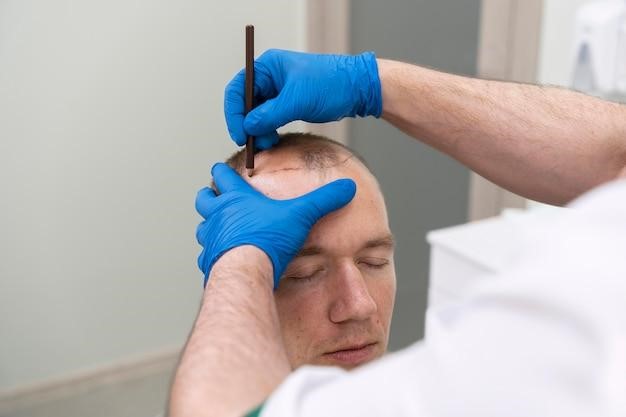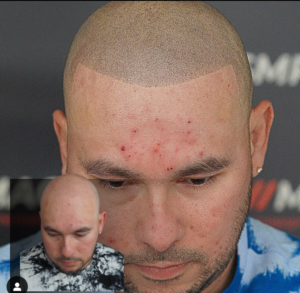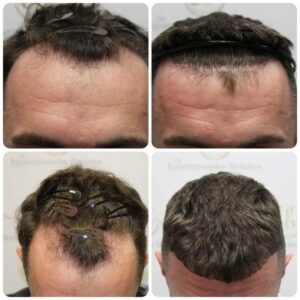Hair loss can be a distressing experience, affecting self-esteem and confidence. While many solutions promise to restore hair, hairline transplants have emerged as a reliable and effective option.
This comprehensive guide will cover everything you need to know about hairline transplants, from understanding the causes of hair loss to choosing the right surgeon, exploring different techniques, and managing post-operative care.
Hair loss happens due to various causes, so the treatment procedure can be specific to certain conditions. So, it is essential to consult an expert before going through this process. This post will discuss all you need to know about hair transplants.

Table of Contents
Key Takeaway
Hairline transplants offer a permanent solution to hair loss, with advanced techniques ensuring natural-looking results. Success depends on choosing an experienced surgeon, understanding the procedure, and following post-operative care guidelines.
The procedure can include two major techniques which have been effective over the years. The FUT and FUE hairline transplant methods efficiently provide solutions to baldness.
What are the Causes of Hair Loss?
Hair loss, or alopecia, can be caused by various factors, including:
1. Genetics: The most common cause of hair loss is androgenetic alopecia, male or female pattern baldness. It is hereditary and progresses with age.
2. Hormonal Changes: Pregnancy, childbirth, menopause, and thyroid problems can trigger hair loss due to hormonal imbalances.
3. Medical Conditions: alopecia areata, scalp infections, and other skin disorders can cause hair loss.
4. Medications: Drugs used for cancer, arthritis, depression, heart problems, and high blood pressure can lead to hair loss.
5. Stress and Lifestyle: High stress levels, poor diet, and lack of proper hair care can contribute to hair loss.
Choosing the Right Hairline Transplant Surgeon
Selecting a skilled and experienced hair transplant surgeon is crucial for success. Here are some factors to consider:
1. Qualifications and Experience: Ensure the surgeon is board-certified and has extensive experience in performing hair transplants.
2. Check out Testimonials: Review the surgeon’s portfolio of previous patients to assess the quality of their work.
3. Patient Reviews: Read testimonials and reviews from past patients to gauge satisfaction levels.
4. Consultation: Schedule a consultation to discuss your expectations, ask questions, and understand the surgeon’s approach and bedside manner.

What are the Types of Hairline Transplant Techniques?
There are two primary hairline transplant techniques:
1. Follicular Unit Transplantation (FUT):
- Involves removing a strip of scalp from the back of the head.
- The strip is dissected into individual follicular units and transplanted to the hairline.
- Leaves a linear scar but can yield many grafts in a single session.
2. Follicular Unit Extraction (FUE):
- A micro-punch tool extracts Individual hair follicles directly from the donor area.
- The follicles are then implanted into the hairline.
- Minimally invasive with no linear scar, but may require multiple sessions for extensive hair loss.
A Step-by-Step Guide to the Hairline Transplant Procedure (Explained)
You will need a comprehensive guide to understand this procedure. A hair transplant takes a few steps, and you must make the right choices and plans to get good results. We have highlighted the steps to achieving a successful hair fix, starting with:
1. Consultation and Planning:
During the initial consultation, the surgeon evaluates your hair loss, discusses your goals, and plans the hairline design.
2. Pre-Operative Instructions:
You will receive instructions on preparing for surgery, such as avoiding certain medications and alcohol and arranging for someone to drive you home post-surgery.
3. Donor Area Preparation:
On the day of surgery, the donor area (usually the back of the head) is trimmed and numbed with local anesthesia. This medication ensures that the donors do not get uncomfortable throughout the period.
4. Harvesting Hair Follicles:
Depending on the chosen technique (FUT or FUE), the surgeon removes a strip off the scalp or extracts individual follicles. In FUT, a strip of scalp is removed from the donor area, typically the back of the head. This strip contains hair follicles that are to be transplanted. FUE involves extracting individual hair follicles directly from the donor area using a micro-punch tool.
5. Graft Preparation:
The harvested follicles are carefully dissected and prepared for transplantation.
6. Recipient Area Preparation:
The hairline is marked, and the recipient area is numbed with local anesthesia.
7. Implanting Grafts:
The surgeon creates tiny incisions in the recipient area and meticulously implants each follicle to match the natural hair growth pattern.
8. Post-Operative Care:
You will receive instructions on caring for your scalp, medications to manage pain and prevent infection, and follow-up appointments for monitoring progress.

Hairline Transplant Post-Operative Care and Recovery
Proper post-operative care is essential for optimal results and a smooth recovery.
I. Immediate Aftercare:
- Avoid touching or scratching the transplanted area.
- Follow the surgeon’s instructions for washing your hair and using prescribed medications.
II. Managing Swelling and Discomfort:
Apply cold compresses to reduce swelling and take pain relievers as prescribed.
III. Activity Restrictions:
Avoid strenuous activities, swimming, and direct sunlight exposure for at least a few weeks.
IV. Monitoring Healing:
Attend follow-up appointments to ensure proper healing and address any concerns.
V. Hair Growth Timeline:
Initial hair shedding is normal, followed by new hair growth typically starting three to four months post-surgery. Full results can take from six months to a year.
What are the Possible Complications/Risks with this Procedure?
While hairline transplants are generally safe, potential complications may happen.
- Infection: Although this symptom might be possible, proper hygiene and prescribed antibiotics minimize this risk.
- Bleeding: Some bleeding is normal, but excessive bleeding would need attention from the surgeon.
- Scarring: FUT may leave a linear scar, while FUE results in tiny, dot-like scars.
- Shock Loss: Temporary hair loss in the transplanted area can occur but usually resolves as new hair grows.
While these symptoms are possible, the chances of getting a successful result have increased, especially with technological development.
How about Scalp Micropigmentation?
Scalp Micropigmentation (SMP) is a non-surgical alternative or complement to hairline transplants. It involves tattooing tiny dots on the scalp to mimic the appearance of hair follicles. SMP can enhance the density of transplanted hair or provide a shaved-head look for those who prefer not to undergo surgery.
Benefits of SMP:
1. Immediate Results: Unlike transplants, SMP offers instant visual improvement.
2. Non-invasive: Minimal downtime and no surgical risks.
3. Versatility: Suitable for hair loss stages and can be combined with hair transplants.
Mac SMP can help with excellent results for people with hair loss or other pattern baldness.
Wrapping Up
Hairline transplants offer a promising solution for those seeking to restore their hair and confidence. You can achieve natural-looking, lasting results by understanding the causes of hair loss, choosing a qualified surgeon, and following the proper procedure and aftercare.
Additionally, alternatives like Scalp Micropigmentation provide flexibility for those exploring different options. With the right approach and care, a hairline transplant can transform your hairline and overall sense of self.
Enjoy This Article? You May Also Like:
- Why Do Bald Patches on the Head Occur and How to Treat Them
- Why is your Hair Dropping Out? Common Causes and Solutions at Mac SMP
- Achieving a Full Head of Hair with Surgical Hair Implants
- Alopecia baldness explained: Causes, treatments, and How Mac SMP can Help
- Balding Hair: Myths Vs. Facts And Effective Strategies To Combat It



